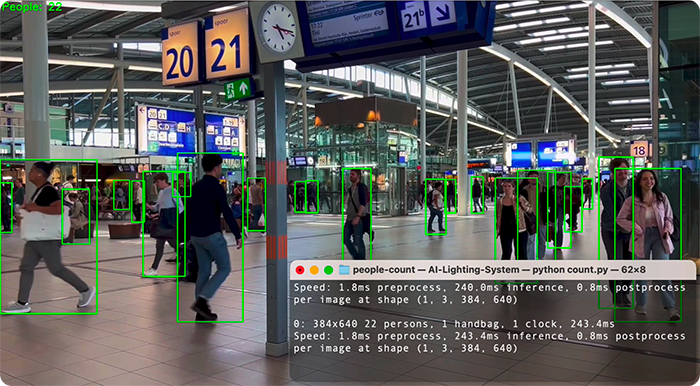
The Transformation of Lighting through AI
XHiLiX Smart Lighting is a pioneering startup founded by York and Nova.

XHiLiX, by analyzing the number of people in the square, drives controllers to achieve lighting at different brightness levels.
XHiLiX,This system connects edge computers, cameras, networked lighting controllers, and so on to the router. By implementing systems that calculate foot traffic and occupancy levels, we can dynamically adjust and control lighting systems. As the number of people in a given area fluctuates, the lighting adapts accordingly, ensuring that spaces are well-lit when needed and dimmed or turned off when they are unoccupied, thus promoting both sustainability and user satisfaction.
One of the most significant impacts of AI on lighting is the ability to create smart, adaptive lighting solutions. By incorporating sensors and machine learning algorithms, today’s lighting systems can automatically adjust brightness and color temperature based on ambient light levels and user preferences. This not only improves comfort but also significantly reduces energy consumption compared to traditional lighting setups.One of the most significant impacts of AI on lighting is the ability to create smart, adaptive lighting solutions.

By incorporating sensors and machine learning algorithms, today’s lighting systems can automatically adjust brightness and color temperature based on ambient light levels and user preferences. This not only improves comfort but also significantly reduces energy consumption compared to traditional lighting setups.
In the ever-evolving landscape of technology, artificial intelligence (AI) has emerged as a catalyst for change across numerous industries, and lighting is no exception. The integration of AI into lighting systems has revolutionized the way we perceive and interact with light, enhancing energy efficiency, user experience, and environmental sustainability.
One of the most significant impacts of AI on lighting is the ability to create smart, adaptive lighting solutions. By incorporating sensors and machine learning algorithms, today’s lighting systems can automatically adjust brightness and color temperature based on ambient light levels and user preferences. This not only improves comfort but also significantly reduces energy consumption compared to traditional lighting setups.
Using edge computing technology, the number of people in a space is calculated in real time. This count, together with the logic table for the lighting system, drives adjustments in brightness to accommodate the needs of varying foot traffic, thereby achieving energy savings and environmental protection.
Moreover, AI-powered lighting systems have the capability to learn from patterns in usage and occupancy. For instance, in commercial buildings or public spaces, lights can dim when areas are unoccupied and brighten upon detecting movement, thereby conserving energy without compromising safety or visibility. In homes, AI can personalize lighting settings according to individual habits and daily routines, ensuring that the environment is always optimized for the user’s needs, whether they’re reading, working, or relaxing.
Another area where AI is making its mark is in predictive maintenance. By continuously monitoring the performance of lighting fixtures, AI can predict potential failures before they occur, allowing for timely repairs and reducing downtime. This proactive approach not only enhances reliability but also extends the lifespan of lighting equipment, contributing to cost savings over time.
In the realm of security, AI-integrated lighting plays a pivotal role by enhancing surveillance capabilities. Intelligent lighting systems can be designed to work in tandem with cameras, alerting security personnel to unusual activity by changing color or intensity, thereby serving as an additional layer of protection.
Lastly, the advent of AI in lighting has opened up new avenues for artistic expression and architectural design. Dynamic lighting schemes that respond to music, weather conditions, or even people’s moods have become possible, adding a new dimension to how spaces are experienced and enjoyed.
As technology continues to advance, the convergence of AI and lighting promises to bring about further innovations, transforming our environments into more efficient, responsive, and harmonious spaces. The future of lighting is smart, sustainable, and increasingly interconnected, thanks to the transformative power of artificial intelligence.Moreover, AI-powered lighting systems have the capability to learn from patterns in usage and occupancy. For instance, in commercial buildings or public spaces, lights can dim when areas are unoccupied and brighten upon detecting movement, thereby conserving energy without compromising safety or visibility. In homes, AI can personalize lighting settings according to individual habits and daily routines, ensuring that the environment is always optimized for the user’s needs, whether they’re reading, working, or relaxing.
Another area where AI is making its mark is in predictive maintenance. By continuously monitoring the performance of lighting fixtures, AI can predict potential failures before they occur, allowing for timely repairs and reducing downtime. This proactive approach not only enhances reliability but also extends the lifespan of lighting equipment, contributing to cost savings over time.
In the realm of security, AI-integrated lighting plays a pivotal role by enhancing surveillance capabilities. Intelligent lighting systems can be designed to work in tandem with cameras, alerting security personnel to unusual activity by changing color or intensity, thereby serving as an additional layer of protection.
Lastly, the advent of AI in lighting has opened up new avenues for artistic expression and architectural design. Dynamic lighting schemes that respond to music, weather conditions, or even people’s moods have become possible, adding a new dimension to how spaces are experienced and enjoyed.
As technology continues to advance, the convergence of AI and lighting promises to bring about further innovations, transforming our environments into more efficient, responsive, and harmonious spaces. The future of lighting is smart, sustainable, and increasingly interconnected, thanks to the transformative power of artificial intelligence.
Copyright Notice: This article is entirely open copyright, allowing forwarding, modification, and commercial use without the need to specify the source.







